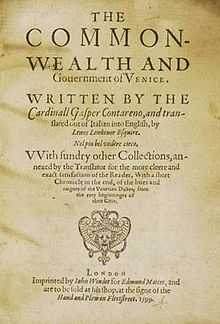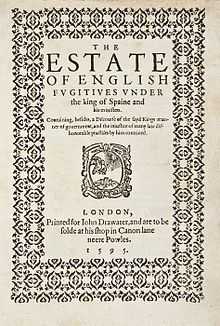Lewes Lewknor
| Lewes Lewknor | |
|---|---|
 The Commonwealth and Government of Venice "translated out of Italian into English by Lewes Lewkenor Esquire" | |
| Born |
c.1560 Selsey, Sussex |
| Died | 11 March 1627 |
| Residence | London |
| Other names | variant spellings: Lewis; Lewkenor |
| Education |
Cambridge University Middle Temple |
| Occupation | Soldier, courtier, M.P. author, Master of the ceremonies |
| Known for |
The Estate of English Fugitives The Commonwealth and Government of Venice |
Sir Lewes Lewknor (c.1560–1627) was an English courtier, M.P. writer and soldier who served as Master of the Ceremonies to King James I of England. M.P. for Midhurst in 1597 and for Bridgnorth 1604-10.[1] His career has been described as a "tortuous trajectory rich in false starts, byways and rather nebulous interludes...[with] slippery religious and political allegiances".[2]
He was noted for his translations of courtly European literature. Particularly important was the translation of Gasparo Contarini's account of the Venetian republic, The Commonwealth and Government of Venice, which influenced contemporary writers including Shakespeare.
He is also widely believed to be the author of an original work, The Estate of English Fugitives, a polemic attacking the Spanish and the machinations of Catholic clergy, while also defending the rights of English Catholics.
Early career
He was the son of Thomas Lewknor of Tangmere and Selsey and his wife Bridget Lewes.[3] He studied at Cambridge and the Middle Temple, working for a short time as a lawyer with his uncle, Richard, but soon sought preferment at court. In the 1580s he was in Spain, apparently as an exile, possibly due to his Catholic sympathies. He attempted a career as a soldier but suffered a disabling injury to his right arm.[2] In 1587 he was living in Antwerp with his wife, but soon returned to England after experiencing financial problems.[4] He reported to Lord Burghley about the activities of English Catholics working for the Spanish. He became a member of parliament for Midhurst in 1597.[3] Lewknor served as a Gentleman Pensioner in Ordinary from 1599 to 1603.
He appears to have accepted the Church of England after his return from the continent, but he returned to Catholicism after the death of Queen Elizabeth.[3]
Master of the Ceremonies

Lewknor became an expert on ceremonial court protocol and as a Gentleman Pensioner, was required to host foreign ambassadors. In 1600 he looked after the French ambassador, travelling with him from Dover to London. In the same year he escorted the Moroccan ambassador Abd el-Ouahed ben Messaoud.
After James I came to the throne in 1603 Lewknor's position was regularised. He was knighted in the same year and he was given the newly created post of "Master of the Ceremonies", for which he received an annual salary of £200. The post was confirmed for his lifetime in 1605.[3] From this point on Lewknor's life was taken up with his duties to attend foreign dignitaries.[3] He was assisted by John Finet, who eventually succeeded him in the post.
At the summoning of James I's first Parliament Lewknor’s uncle, Richard (chief justice of Chester and a prominent member of the Council in the Marches) secured his return for Bridgnorth. In the first session of the Parliament Lewes made five speeches and Between 1604 and 1610 he sat on 37 committees. The King also selected him to be among those ordered to manage the ‘matter of estate foreign or matter of intercourse’ at the conference with the Lords of 28 April 1604 on the Union with Scotland.[5]
Writings
Lewknor's publications were mostly translations of courtly and political works by continental European writers. In 1594 Lewknor wrote The Resolved Gentleman, a translation of Hernando de Acuña's version of Olivier de la Marche's le Chevalier délibéré. Lewknor's version of this chivalric allegory has recently been interpreted as "a subtle, perceptive but scathing criticism of the Elizabethan court in the 1590's".[2]

In 1595 A Discourse of the Usage of the English Fugitives, by the Spaniard,[6] was published, which became very popular having four reprintings in two years, expanded with the title The Estate of English Fugitives under the king of Spaine and his ministers. The book gave a colourful account of the author's adventures as a soldier of fortune in the Netherlands; it attacked the Spanish and the Catholic clergy, addressing English Catholics with the assertion that "They make you and other Catholics believe that what practices and drifts so ever they take in hand, are all for the zeale of religion...and you silly foules think all they saie to bee Gospell, whereas – God Wot – religion is the least matter of a thousand they think upon."[7] Published under the initials "L.L.", the work has been attributed to Lewknor.[3][8] Despite the initials, it has also been sometimes attributed to Lewes' brother Samuel Lewknor, who had returned from Europe in 1594 and published an account of his travels.[9][10] Historian Marco Nievergelt, however, says that Lewes is "generally accepted" as its author.[3]
His 1599 translation of Gasparo Contarini's De Magistratibus et Republica Venetorum (as The Commonwealth and Government of Venice) demonstrates "the admiration Englishmen could express towards aristocratic republics".[11] Lewknor described the republic as a combination of genius and divine favour: "as it were entertaining a league of intelligence with heavenly powers". The book influenced the portrayal of Venice in literature, notably in Shakespeare's plays, Othello especially, and Ben Jonson's Volpone.[12][13] The book also included material adapted from other sources, including passages from Donato Gianotti's Libro de la Republica di Venetiana, providing additional historical information, and content from books giving details of local geography and customs.[13]
The Spanish Mandevile of Miracles, or, The Garden of Curious Flowers, apparently a work written in his youth, was published in 1600. It is a translation of Antonio de Torquemada's, Le Jardin Flores Curiosas. The book was published by Ferdinando Walker in 1600 and dedicated to Thomas Sackville, 1st Earl of Dorset who had been made Lord High Treasurer after the death of William Cecil, Lord Burghley in 1598.
Lewknor was one of Prince Henry's circle and contributed Old Wormy Age, a humorous panegyric verse, to the preface of Thomas Coryat's Coryat's Crudities: Hastily gobled up in Five Moneth’s Travels published in 1611.
Family
Sometime before 1588, while in the Spanish Netherlands, Lewknor married Beatrice de Rota.[3] The couple had two sons, William,[14] and Thomas (1587-1645)[15] as well as a daughter, Beatrice. William was named in the Selsey lease of 1597 and in 1606 he was in Angers consorting with the Jesuits.[16] His wife, Beatrice de Rota, died from smallpox in March 1605 and Lewes quickly married Katherine Argall (née Bocking), the widow of his cousin Sir Thomas Argall, but Katherine also died from the pox within six months of the marriage. He finally married Mary Blount, daughter of Sir Richard Blount of Dedisham and in 1624 the couple were 'justly suspected to be popish recusants'.[17] In May of 1624 Lewkenor spent sometime incarcertaed in The Tower of London[18] for ordering a ship for the Spanish ambassador without authorisation.
Following the funeral of James I Lewkenor was accused by the Venetian ambassador, Zuane Pesaro[19] of deliberately excluding him from the funeral. Lewkenor pleaded ill health but he still spent some time in the Marshalsea and was suspended from his office. He suffered seven months of house arrest[20] until the Venetian relented and he was restored to his post. Lewkenor and his wife were twice more accused of being recusants at the Middlesex sessions.
Lewkenor's last official engagement was on Sunday 29 November 1626, when Charles I dispatched him to attend François de Bassompierre [21] 'Lucnar came to bring me a very rich present from the king, of four diamonds set in a lozenge, and a great stone at the end; and the same evening sent again to fetch me to hear an excellent English play'.
Lewes Lewkenor died on 11 March 1627 and his post of Master of the Ceremonies reverted to his assistant John Finet. Lewknor's son Thomas survived him, but having become a Jesuit priest he died childless in 1645.[3][22]
References
| Wikisource has original works written by or about: Lewes Lewknor |
- ↑ http://www.historyofparliamentonline.org/volume/1604-1629/member/lewknor-sir-lewis-1560-1627#footnoteref42_p9fccjy
- ↑ 2.0 2.1 2.2 "Catholic loyalism, service and careerism: Lewes Lewkenor's quest for favour", Renaissance Studies, Volume 24, Number 4, 2010, pp. 536–558
- ↑ 3.0 3.1 3.2 3.3 3.4 3.5 3.6 3.7 3.8 Lewknor, Lewis in P.W. Hasler, The History of Parliament: the House of Commons 1558–1603, ed., 1981
- ↑ Archives Generales du Royuame, Brussels, Papiers D’ete et du Audience- A.G.R, P.E.A 1830/3 n.f. depositions of 9 and 13 February 1587; 23 July 1588.
- ↑ http://www.historyofparliamentonline.org/volume/1604-1629/member/lewknor-sir-lewis-1560-1627#footnote30_tmf2msg
- ↑ Clifford, Arthur, ed., Sadler State Papers, vol. 2, Edinburgh (1809)
- ↑ Albert J. Loomie, The Spanish Elizabethans:The English Exiles at the Court of Philip II, Fordham University Press, New York, 1963, p.11
- ↑ Alexandra Gajda, The Earl of Essex and Late Elizabethan Political Culture, Oxford University Press, 2012, p.87.
- ↑ Samuel published his account of the Universities he had encountered on his travels A Discourse Not Altogether Vnprofitable, Nor Vnpleasant for Such as are Desirous to Know the Situation and Customes of Forraine Cities Without Trauelling to See Them: Containing a Discourse of All Those Citties Wherein Doe Flourish at this Day Priuiledged Vniuersities
- ↑ J. N. Hillgarth, The Mirror of Spain, 1500–1700: The Formation of a Myth, University of Michigan Press, 2000, p.443.
- ↑ Markku Peltonen, "Citizenship and Republicanism in Elizabethan England" in Martin Van Gelderen (ed), Republicanism: A Shared European Heritage. Volume: 1., Cambridge University Press, 2002, p.99.
- ↑ Robin Headlam Wells, "Shakespeare on Masculinity", Cambridge University Press, 2000. p.110.
- ↑ 13.0 13.1 David McPherson, Lewkenor's Venice and Its Sources, Renaissance Quarterly, Vol. 41, No. 3, Autumn, 1988, pp.459–466.
- ↑ CSP Dom. V. 262. 9 January 1597.
- ↑ 19 September 1614. Quoted in C. Dodd’s Church History of England from the commencement of the sixteenth century to the revolution in 1688, ed. Tierney, vol. iv. Appendix, p. ccxli.
- ↑ 1606, 21 November/1 December. Tibbot Gorges to the Earl of Salisbury. 'Cecil Papers: November 1606', Calendar of the Cecil Papers in Hatfield House, Volume 18: 1606 (1940), pp. 337-355.
- ↑ 'House of Lords Journal Volume 3: 20 May 1624', Journal of the House of Lords: volume 3: 1620-1628 (1767-1830), pp. 392-396. URL: http://www.british-history.ac.uk/report.aspx?compid=30423
- ↑ 15 May. London. Sir Fras. Nethersole to [Carleton]. James 1 - volume 164: 1-18 May 1624', CSP Dom: James I, 1623-25, pp. 230-249
- ↑ CSP VEN. Pesaro to the Doge and Senate, London, the 24th May, 1625.
- ↑ Charles I - volume 10: 18-30 November 1625’, Calendar of State Papers Domestic: Charles I, 1625-26 (1858), pp. 152-166.
- ↑ Memoirs of the Marshal de Bassompierre, 1819, John Wilson Croker. p.107
- ↑ "Lewes Lewknor". Oxford Dictionary of National Biography. Retrieved 7 January 2015.